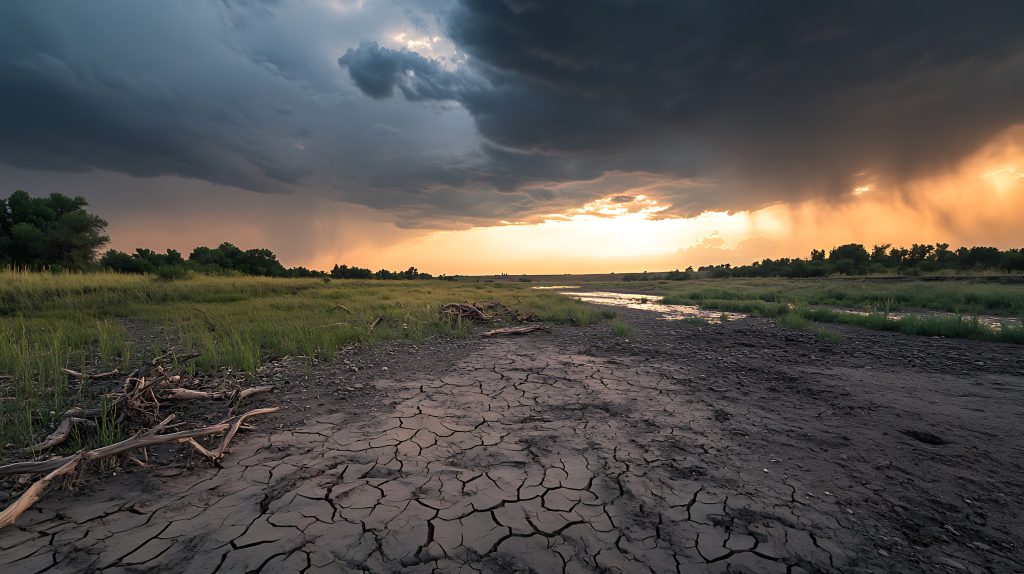A few hours of rain are enough for lawns to turn green and flowers to bloom. For this reason, many people believe that drought is an easily reversible problem, and that a week of heavy rain is enough to stave off a prolonged drought. However, hydrology isn’t so simple. Drought is a complex, multi-stage, and often hidden phenomenon, and its reversal depends not solely on the previous week’s weather. Short-term rainfall isn’t enough to address the consequences of drought. But what does effective “irrigation” actually look like?
What exactly is drought?
While the word “drought” sounds straightforward, experts distinguish four distinct types of drought. Each relates to a different element of the environment and requires a different approach. Understanding these differences is key to avoiding falling for the appearance of improvement after a day or two of rainfall.
1. Atmospheric (meteorological) drought
This is the most visible and basic type of drought. It occurs when there is a significant decrease in the amount of precipitation, such as rain, snow, or drizzle, compared to long-term averages over a prolonged period. Vegetation begins to wilt, the ground cracks, and the first effects of water shortage appear. Atmospheric drought is easy to observe and just as easy to end – even a few days of rain can stop it.
2. Agricultural (soil) drought
This type of drought concerns not only the lack of rainfall, but also its effects on the soil and crops. The soil lacks moisture, preventing plants from absorbing water even when they are still alive. Agricultural drought is particularly dangerous in spring and summer, when crops are in the growth phase and need water most.
3. Hydrological drought
Hydrological drought affects all surface water resources, such as rivers, lakes, and ponds. We observe it when rivers begin to lack water, their flow and level fall below seasonal norms, and lakes and reservoirs cease to regenerate. The consequences? Threats to surface water intakes and ecosystems, as well as disruptions to hydropower generation, problems with power plant cooling, and restrictions on navigation.
Crucially, this form of drought does not disappear after a short rainfall. Rainfall must be regular, prolonged, and cover the entire river basin for water levels to normalize.
4. Hydrogeological drought
This is the most “invisible” type of drought and the most dangerous in the long term. Hydrogeological drought occurs when groundwater levels drop so low that they are no longer accessible to wells, springs, or natural seeps.
In Poland, as much as 70% of drinking water supplies come from groundwater, so its shortage poses a real threat to households, industry, and agriculture.
Rebuilding these resources is the most difficult task, as rainfall must be of sufficient intensity and duration (gentle and prolonged) to allow water to slowly percolate down into the soil, reaching aquifers. This process takes months, not days.
Lower intensity, temporal distribution, and geographic scope – these are the keys to success.
One of the most misleading phenomena is intense, short-lived rains. 20–30 mm of water can fall in an hour, which theoretically is equivalent to weeks of “normal” rainfall. But this water doesn’t have time to soak into the ground. It flows across the surface, collecting pollutants, and doing more harm than good, causing flooding, soil erosion, and infrastructure damage. The result? The water is quickly discharged into rivers and then into the sea, but it doesn’t accumulate in the landscape, in the soil, and doesn’t adequately recharge aquifers. The land cannot absorb such a large rainfall in such a short period.
Another important aspect is the distribution of rainfall. We often observe situations where one part of the country experiences prolonged and intense rainfall, while another receives almost none. Therefore, we cannot judge the situation solely on local weather conditions. Even if it rained in our area, rivers that begin 100 km away may still be drying up.
How long does it take for drought to be reversed? This is one of the most common, yet most difficult, questions to answer. We can only use approximations:
- Atmospheric drought – may subside after 2–3 days of rainfall if the total exceeds local norms.
- Agricultural drought – improvement occurs after approximately 7–10 days of moderate rainfall, but only if not accompanied by heat.
- Hydrological drought – requires at least several weeks of moderate, regular rainfall covering the entire catchment area.
- Hydrogeological drought – groundwater resources can only recover after more than a month of moderate, regular rainfall.
Remember, it’s not just about the amount of water, but also the timing and method of its delivery to the environment.
The climate is changing – and with it, precipitation.
Climate change, which is increasingly affecting Poland, is causing droughts to become longer and more severe, and rainfall more and more unpredictable. The old pattern of “rainy spring, dry summer, wet autumn” is no longer working. On the one hand, we have increasingly frequent and longer rainless periods, lasting up to 60 days, something that was extremely rare just a few decades ago. On the other, we have sudden, intense rainfall that is unable to be absorbed into the soil. All this means we are losing more water than we are gaining, and Poland’s hydrological balance is working against us.
Furthermore, prolonged high temperatures caused by climate change not only cause discomfort for us but also increase water evaporation from plants, soil, reservoirs, and rivers (evapotranspiration). Simply put, the warmer the weather, the faster water escapes from the landscape. The autumn and winter seasons should also be considered here. If temperatures during this period are higher than the multi-year average, we also observe greater evaporation than in previous years. Remember, evaporation isn’t just about temperatures above 30 degrees Celsius.
Summer, however, often sees heavy, sudden rainfall. If such rainfall is followed by another heatwave, the benefits of the rainfall can be negated in just one day.
What can be done?
Systemic measures:
- Increasing water retention – that is, retaining water in the landscape, for example, by creating ponds, water features, or rain gardens.
- Modernizing drainage systems – transforming them into dual-purpose systems: draining and retaining water.
- Sustainable agriculture – including mulching and selecting drought-resistant varieties.
Individual measures:
- Harvesting rainwater – for irrigation, flushing toilets, etc.
- Reducing water consumption – shorter bathing sessions, avoiding watering plants during peak hours of sunlight and high temperatures.
- Planting deep-rooted plants – they tolerate drought better and improve soil structure.
The websites of institutions such as IMWM-PIB, IUNG, and PIG-PIB offer up-to-date maps and reports on drought and soil moisture, presenting the situation in various regions of the country. This data includes both current measurements and forecasts, allowing for the assessment of drought risk and the tracking of changes over time. All information is publicly available: IMWM-PIB, IUNG, and PIG-PIB.
Summary
Rain is always good news, but not every drop changes the hydrological situation in our country. To effectively counteract the effects of drought, we need weeks or even months of regular rainfall, ideally distributed over time and space. On average, Poland receives the same amount of rainfall as 20, 30, or 50 years ago. But the devil is in the details; in this case, it’s precisely the timing and space in which this rainfall occurs.
Today, understanding what drought is and how to combat it is not only the task of scientists and officials, but also of each of us. It’s not easy, it’s not the same in every place. The drought problem is multifaceted. That’s why it’s so important to work across the board, working together. Because water isn’t just a farmers’ problem, but a shared good and shared responsibility.

 PL
PL

